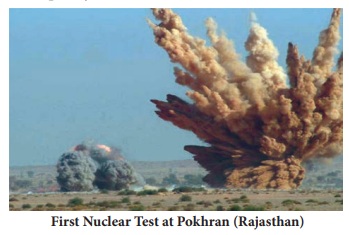India’s Foreign Policy - The Non-Aligned Movement (NAM) in 1961 | 10th Social Science : Civics : Chapter 4 : India’s Foreign Policy
Chapter: 10th Social Science : Civics : Chapter 4 : India’s Foreign Policy
The Non-Aligned Movement (NAM) in 1961
The Non-Aligned Movement (NAM) in 1961
The term
‘Non-Alignment’ was coined by V. Krishna Menon in his speech at the United
Nations in 1953. Non-alignment has been regarded as the most important feature
of India’s foreign policy. It aimed to maintain national independence in
foreign affairs by not joining any military alliance. The Non-Aligned Movement
(NAM) was formed with a membership of 120 countries and 17 states as observers
and 10 international organisations. It has transformed from a political
movement to an economical movement.
The founding fathers of
Non-Aligned Movement : Jawaharlal Nehru of India, Tito of Yugoslavia,
Nasser of Egypt, Sukarno of Indonesia, and Kwame Nkrumah of Ghana were the
founding fathers of NAM.
India's Foreign Policy during Cold War Era
The
Non-alignment roots did not prevent India from entering into an alignment with
the Soviet Union by the Indo-Soviet treaty of 1971 (20-year pact of ‘peace,
friendship and co-operation’). Then India embarked on a substantial programme
of military modernisation. In 1974, India also conducted its first nuclear test
at Pokhran under Subterranean Nuclear Explosions Project, in response to
China’s nuclear test in 1964 at Lop Nor.
Changing
global conditions determine the foreign policy details. India got her political
freedom in the aftermath of a disastrous Second World War, and India had to be
redeemed from acute poverty illiteracy, and chaotic socio-economic conditions.
Hence our new nation could not afford to military entanglements and military
alliances. Avoidance of military blocs was then not an option but a necessity.
Non Alliance did not mean neutrality, but the freedom of nations to decide on
issues independently. Non-alliance did not mean demilitarisation of nations. It
was meant to ensure de-escalation of conflicts and tension. Even wither
discarding the ‘Non-Alliance’ India could enormously strengthen her defence
system and could become a nuclear power. Flaws or faults in details of foreign
policy executions have been addressed time and again but India’s basic policy
of non-Alliance is still in force.

New Developments: in the 1990s and the 20th Century
During
the 1990’s along with the fall of the Soviet Union, a new global economic order
(Liberalisation, Privatisation, and Globalisation) emerged with the support of
the western powers. India entered into pacts with global economic forum (GATT)
and entered into bilateral, trilateral, multilateral agreements. Its nuclear
experiments resulted in intimidatory reactions from the western world.
This
shifts in India’s policy manifested in various ways such as
• Better relations with China – the Look East
Policy (1992)
• The second nuclear test at Pokhran (1998) in
Rajasthan
• Defence procurement relationship with Israel
• Energy diplomacy with Arab countries and Iran
• Agreeing to US nuclear missile defence program
and
• India’s vote against Iran at the International
Atomic Energy Agency
India in the Resurgent 21st Century
The
foremost task of India’s foreign policy is to enable the domestic
transformation of India.
India has
adjusted to meet the needs of intensified economic engagement with the world,
which is designed to meet the needs of an increased inflow of capital,
technology, ideas and innovation for our development and our re-emergence as
one of the world’s leading economies.
India
engages with current global subjects and articulates its international policies
in order to gain a prominent place and makes its presence felt in on a global
scale. It has joined new global groups like the Group of 20 (G-20), India,
Brazil, South Africa (IBSA), and Brazil, Russia, India, China, South Africa
(BRICS), which gives more scope for India to play a larger role in global
affairs.
India’s
global security concerns are reflected in its military modernisation, maritime
security and nuclear policies. India has emerged as a major voice in global
decision-making and management, and as a bridge and balancing power in the
emerging global strategic architecture. The response of our policymakers at
economic, political and strategic level have enabled India to emerge as a
potential great power though it faces enormous developmental challenges. These
challenges include sustaining the country’s economic growth rate, ensuring
energy and security. Non-military issues like climate change, energy security,
competition for scarce resources, food and water security, pandemics and
migration. Though numerous and formidable, these challenges are not beyond the
reach of India’s policy establishment.
Related Topics